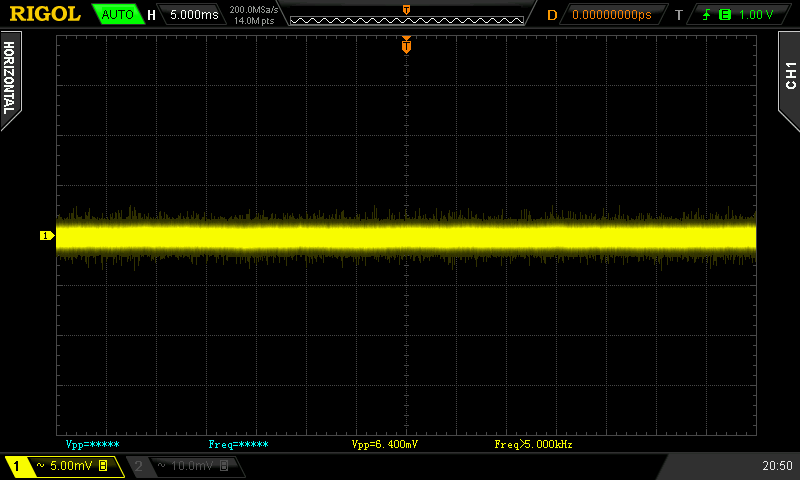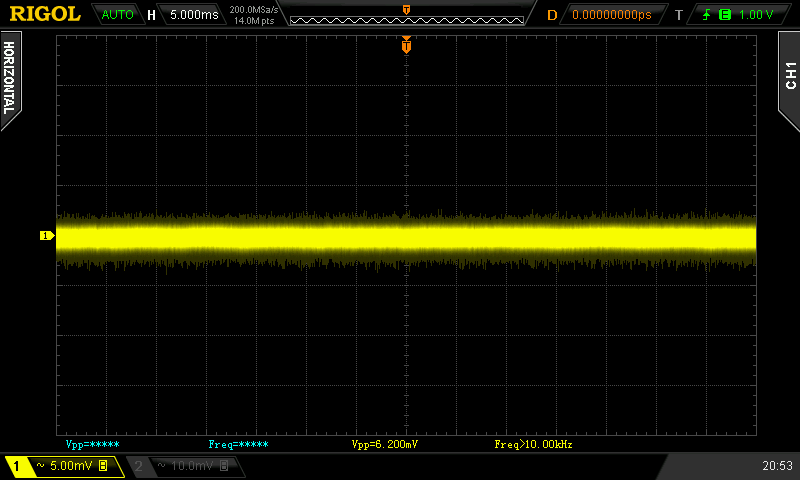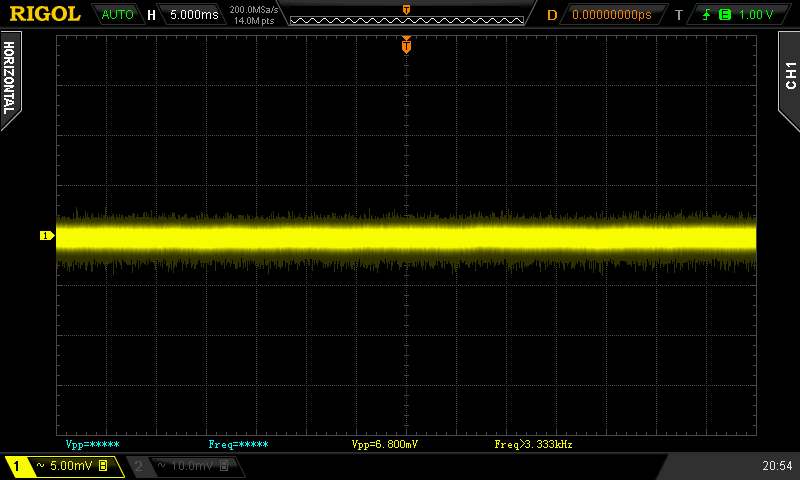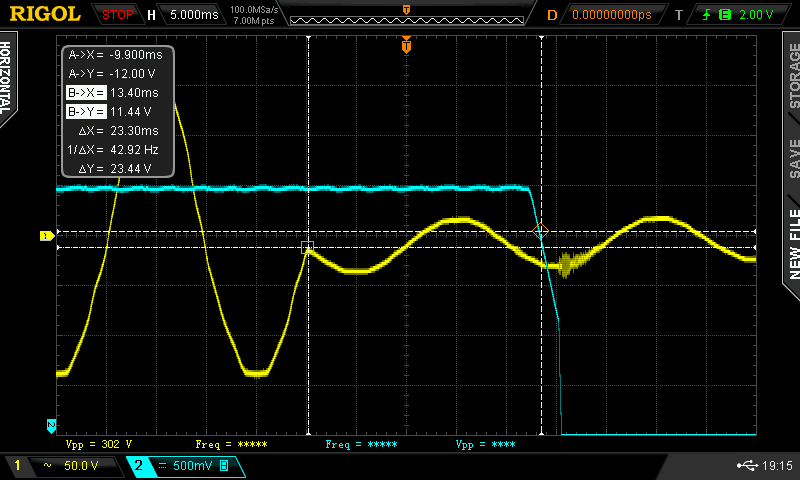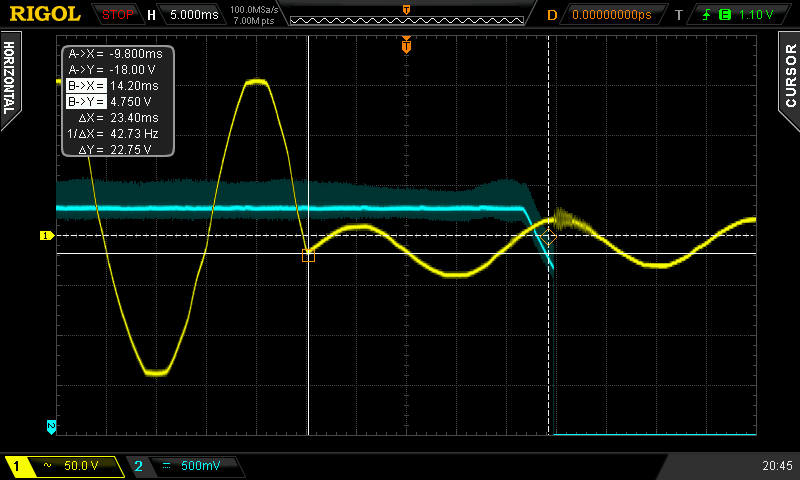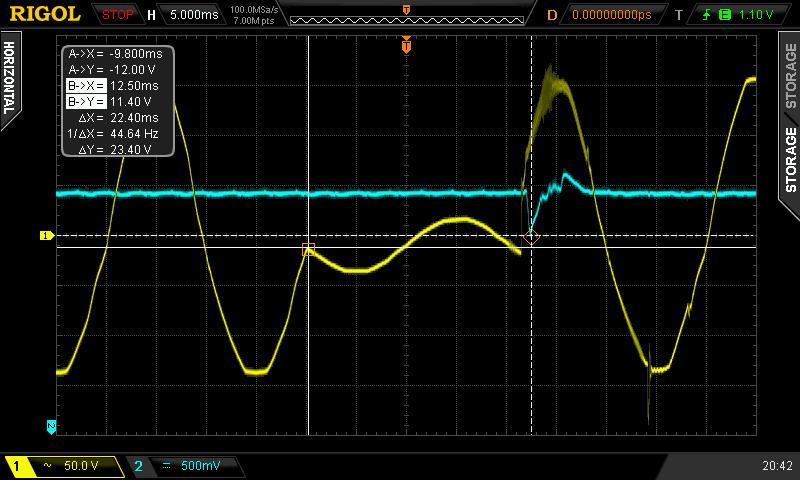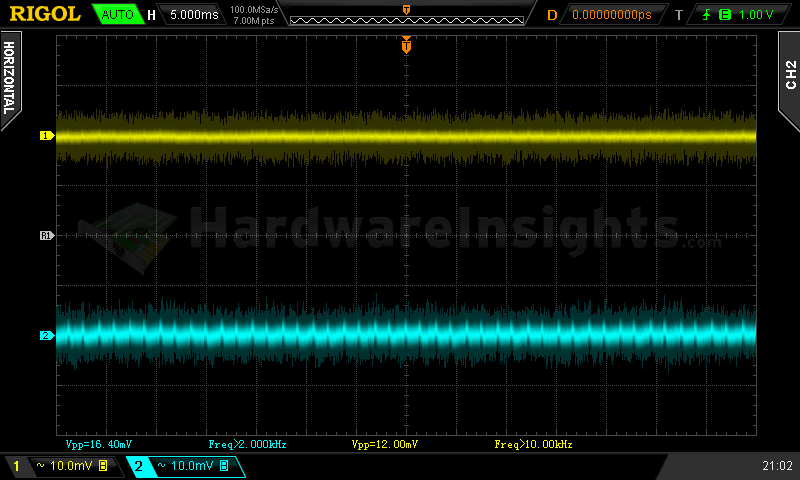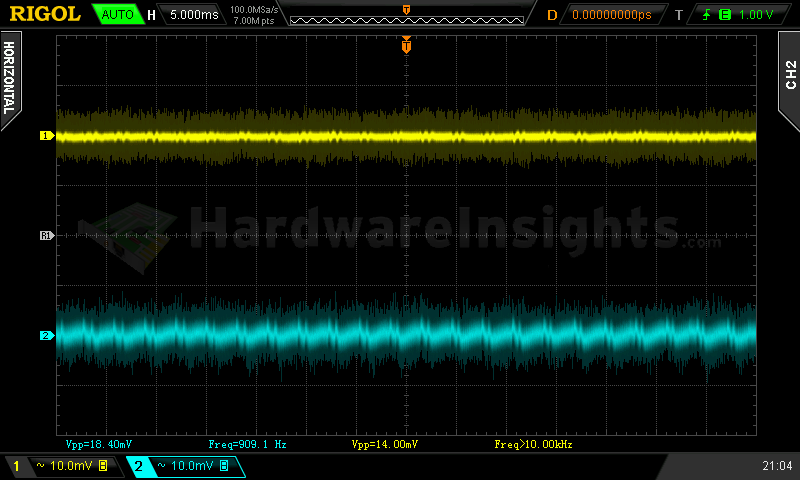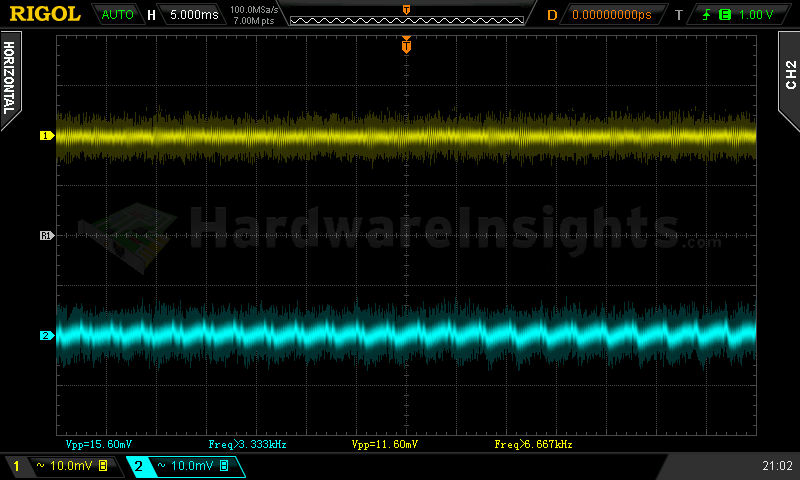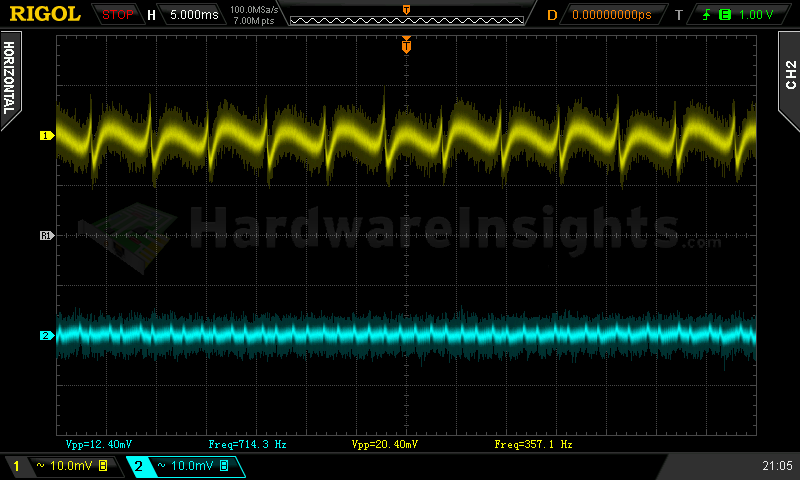Contents
- 1Introducing the Be Quiet! Pure Power 9 CM 600 W (L9-CM-600W)
- 1.1Packaging and accessories
- 2Connectors & cabling
- 2.1Casing & cooling
- 3Input filtering
- 4Primary side
- 4.1+5 V stand-by rail
- 5Secondary side
- 5.1Build quality
- 6Load testing
- 6.1Loading +5 V SB
- 6.2Voltage hold-up time
- 6.3Combined loading
- 6.4Combined loading ripple
- 6.5Crossloading, overloading
- 6.6Crossloading, overloading ripple
- 6.7Fan speed, temperatures and noise
- 7Conclusion and evaluation
- 7.1Thanks
- 7.2Discussion
Load testing
Loading +5 V SB
As always, all load testing is done according to our testing methodology. The voltage regulation is nice for mainstream unit, it stays within 1 %. But the efficiency is lower at around 71 %. Ripple suppression is OK.
| Output (W) | Load (A) | Voltage (V)/ ripple (mV) | Input (W) | Efficiency/power factor |
| 0 | 0 | 5.05/6.400 | 0 | —/0.010 |
| 14.45 | 2.90 | 4.99/6.200 | 20.31 | 71.2 %/0.507 |
| 16.88 | 3.39 | 4.98/6.800 | 23.68 | 71.3 %/0.582 |
+5 V SB ripple (left to right): 0 A; 2.90 A; 3.39 A
Voltage hold-up time
As we can see on the oscilloscope screenshot, the hold-up time of the +12 V rail is quite long at 23.3 ms. This is good result.
The power good signal hold-up time is also very long, 23.4 ms. It is even slightly longer though it should be the other way arround, but the difference is negligible and I would say within reasonable margin of error.
Interrupting the AC input exactly for 23.3 ms revealed some transient voltages spikes so for the voltage to stay within spec I had to reduce the time to about 21 ms. Still a good result.
Combined loading
Combined loading was OK for the Be Quiet! L9-CM-600W. Firstly, let’s talk about the voltage regulation. Though this is a synchronously-rectified topology, its transformer carries all the windings for separate rails whuch usually means not the best results. Though I kept relatively high load on both +3.3 and +5 V rails, the regulation was not great really. The +5V rail voltage was more or less stable, but +12V rail voltage was just falling like a rock. The absolute value of regulation was within 2 %, but relatively, the change was higher. The difference is 0.36 V so this is not that great, it means much greater stress for VRMs on your motherboard or graphics card especially in case of sudden but frequent changes of power draw.
| Output power | Load/ voltage +5 V SB | Load/ voltage +3.3 V | Load/ voltage +5 V | Load/ voltage +12 V | Load/ voltage −12 V | Input power | Efficiency/ power factor |
| 4.5 %/ 27.19 W | 0 A/ 5.04 V | 0 A/ 3.36 V | 0.298/ 5.02 V | 1.839 A/ 12.14 V | 0.292 A/ −11.48 V | 36.40 W | 74.7 %/ 0.815 |
| 20 %/ 116.43 W | 0.531 A/ 5.02 V | 2.88 A/ 3.34 V | 3.32 A/ 4.99 V | 6.96 A/ 12.10 V | 0.291 A/ −11.54 V | 134.1 W | 86.8 %/ 0.959 |
| 40 %/ 242.57 W | 1.01 A/ 4.99 V | 3.03 A/ 3.33 V | 4.80 A/ 4.99 V | 16.66 A/ 12.01 V | 0.293 A/ −11.61 V | 273.5 W | 88.7 %/ 0.984 |
| 60 %/ 364.22 W | 1.89 A/ 4.96 V | 5.75 A/ 3.30 V | 5.90 A/ 4.98 V | 25.4 A/ 11.93 V | 0.295/ −11.70 V | 414.9 W | 87.8 %/ 0.992 |
|
80 %/ 493.10 |
2.37 A/ 4.93 V | 7.31 A/ 3.29 V | 7.72 A/ 4.99 V | 35.1 A/ 11.83 V | 0.305 A/ −11.79 V | 571.3 W | 86.3 %/ 0.994 |
| 100 %/ 592.46 W | 2.82 A/ 4.97 V | 10.07 A/ 3.27 V | 9.02 A/ 4.98 V | 42.2 A/ 11.78 V | 0.306 A/ −11.88 V | 698.2 W | 84.9 %/ 0.995 |
As for the overall efficiency, it reached almost 89 % on my bench. That is nice value though also a little bit lower than what Ecova states in their report. But in similar manner, the efficiency increased suddenly before the output reached 50 % and than was falling quite much. Seems like this platform is more suited for 550W output. This is common situation for Raider/Aurum platforms.
Combined loading ripple
The ripple values are exceptional though, at least for mainstream unit. Here the L9-CM-600W shows very good results.
| Output % | Ripple +5 V SB | Ripple +3.3 V | Ripple +5 V | Ripple +12 V | Ripple −12 V |
| 4.5 | 12.00 mV | 14.00 mV | 11.60 mV | 18.40 mV | 20.40 mV |
| 20 | 10.20 mV | 6.200 mV | 5.00 mV | 16.40 mV | 16.80 mV |
| 40 | 10.40 mV | 5.60 mV | 8.00 mV | 12.80 mV | 17.00 mV |
| 60 | 9.20 mV | 7.200 mV | 7.80 mV | 17.60 mV | 16.40 mV |
| 80 | 10.60 mV | 12.80 mV | 9.40 mV | 17.20 mV | 17.20 mV |
| 100 | 14.00 mV | 14.80 mV | 13.00 mV | 16.40 mV | 22.00 mV |
I just somehow forgot to save the screenshots the second time…
Ripple 4.5% load (left to right): +5 V SB; +3.3 V; +5 V; −12 V. The second channel is connected to +12 V.
Crossloading, overloading
Crossloading tests did not go well. This is actually the reason why the article was delayed so much. When I finally got to the load testing, I found this unit was barely, but out of spec on voltage regulation under crossload. But I have been warned even before the testing that there may be some defective units sent as samples so I decided to give Be Quiet! another chance. It took some time to get second sample which initially showed better results. But under full testing, the results were basically the same. Crossloading +3.3V rail was OK. But not so much with +5V crossload, then the voltage fell down under ATX minimum to 4.72 V. And I was not even drawing the full output of the rail. When increasing the draw from +12V rail to about 3.5 A (over 40 W from +12 V against less than 90 W from +3.3/+5 V combined), the voltage was still out of spec. Similar situation happened with +12V crossload when the voltage decreased to only 11.38 V (though increasing +5V load increased also the voltage above the minimum of 11.4 V).
| Output power | Load/ voltage +5 V SB | Load/ voltage +3.3 V | Load/ voltage +5 V | Load/ voltage +12 V | Load/ voltage −12 V | Input power | Efficiency/ power factor |
| 19 %/ 112.9 W | 0.545 A/ 5.01 V | 23.4 A/ 3.28 V | 1.429 A/ 4.88 V | 1.849 A/ 12.40 V | 0.302 A/ −11.79 V | 146.2 W | 77.2 %/ 0.960 |
| 20 %/ 118.36 W | 0.531 A/ 5.02 V | 1.482 A/ 3.33 | 17.7 A/ 4.72 V | 1.914 A/ 12.37 V | 0.302 A/ −12.03 V | 142.7 W | 82.9 %/ 0.963 |
| 94 %/ 562.66 W | 0.542 A/ 4.98 V | 1.458 A/ 3.29 V | 1.502 A/ 5.17 V | 47.8 A/ 11.38 V | 0.296 A/ −11.62 V | 664.2 W | 84.7 %/ 0.995 |
| 119 %/ 711.13 W | 3.35 A/ 4.89 V | 10.99 A/ 3.25 V | 16.0 A/ 4.92 V | 49.8 A/ 11.58 V | 0.303 A/ −11.87 V | 844.7 W | 84.2 %/ 0.996 |
So this is clearly a platform problem when two different units behaved the same way. Aurum/Raider platforms always have been very problematic in crossload though so far, they always managed to stay within spec, though often very barely (like the Silverstone Strider Essential Gold 600 W). Now when Be Quiet! would have specified some minimum loads on each rail at least for crossload, I would leave it pass. But they most likely trusted this platform too much when they specified only 0.1A draw from the first +12V rail. The platform showed it cannot handle that. Unlike what I have been told by Be Quiet! representatives, the opposite is true and similar results were achieved by Tom’s hardware (though their methodology puts even more stress on a unit under crossload) and TweakPC. And the ATX norm is very strict here: voltage regulation in spec under crossload is obligatory. So according to my methodology, any unit which does not pass here will obtain failed status.
As for the protections, this is finally the first Aurum/Raider based unit which has over-temperature protection present, and it is working. The unit turned off after just 35 seconds when I stuck the fan though. Also the OCP at least on one of the +12V rails I tested was working, the unit turned off after reaching 43 A. Other rails did not respond to maximum draw I have been able to apply to them. OPP was not working, as usually with this platform: maximum I got under combined overload was about 120 % of nominal power, than the voltages started to fall rapidly. UVP kicked in under 10.6 V on +12V rails. This is not working UVP to me either.
Crossloading, overloading ripple
The ripple values were mostly the same here as under the combined loading tests.
| Output % | Ripple +5 V SB | Ripple +3.3 V | Ripple +5 V | Ripple +12 V | Ripple −12 V |
| 19 | 13.00 mV | 18.40 mV | 16.60 mV | 18.40 mV | 20.80 mV |
| 20 | 10.20 mV | 8.20 mV | 12.00 mV | 18.40 mV | 18.60 mV |
| 94 | 12.00 mV | 10.80 mV | 17.40 mV | 16.40 mV | 17.40 mV |
| 119 | — | — | 30.00 mV | 20.40 mV | — |
Fan speed, temperatures and noise
The fan of the L9-CM-600W started spinning right away, but until test five (80 % load) it stayed at just about 580 RPM, and at that speed it was basically inaudible. The ambient noise was slightly higher this time but the unit did not really crossed that until it reached 1000 RPM. It is noticeable since approx. 1100 RPM but it never reached speed to be loud.
| Output % | Fan speed (RPM) | Temperature intake/ outtake | Noise (dBA) |
| 4.5 | 576 | 27 °C/ 29 °C | 39.0 |
| 20 | 578 | 27 °C/ 31 °C | 39.0 |
| 40 | 576 | 27 °C/ 35 °C | 39.0 |
| 60 | 575 | 28 °C/ 40 °C | 39.0 |
| 80 | 1003 | 30 °C/ 46 °C | 39.2 |
| 100 | 1277 | 31 °C/ 48 °C | 39.4 |
| CL 19 | 611 | 29 °C/ 40 °C | 39.0 |
| CL 20 | 621 | 28 °C/ 36 °C | 39.0 |
| CL 94 | 1142 | 31 °C/ 46 °C | 39.3 |
| OL 119 | 1420 | 29 °C/ 46 °C | 39.8 |
The temperatures were higher as also the ambient temperature was higher. Plus the low fan speed also plays a significant role. As usually for units which have slowly-running fan, I would recommend this unit for well-cooled builds, if it passed loading tests in spec. The short time to overheat at full load (35 seconds) shows that the cooling does not really have that much of overhead in the effort to stay silent.
